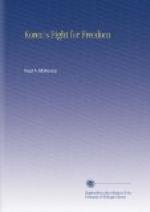In the summer of 1881 there was a famine in the land. The Regent’s agents were busy everywhere whispering that the spirits were angry with the nation for admitting the foreigner, and that Queen Min had brought the wrath of the gods on them. The National Treasury failed, and many of the King’s soldiers and retainers were ready for any trouble. A great mob gathered in the streets. It first attacked and murdered the King’s Ministers, and destroyed their houses. Then it turned against the King’s palace.
Word came to the Queen’s quarters that the rioters were hammering at the gates and would soon be on her. The palace guards had weakened, and some had even joined the people. Queen Min was calm and collected. She quickly changed clothes with one of her serving women, who somewhat resembled her in appearance. The serving woman, dressed in the robes of the Queen, was given a draught of poison and died.
The Queen hurried out through a side way, in peasant woman’s dress, guarded by a water carrier, Yi Yung-ik, who for his services that day rose till he finally became Prime Minister of the land. When the crowd broke into the Queen’s private apartments, they were shown the corpse and told that it was the Queen, who had died rather than face them.
The crowd swept on and attacked the Japanese Legation. The Minister, Hanabusa, and his guard, with all the civilians who could reach the place—the rest were murdered—fought bravely, keeping the mob back until the Legation building was set afire. Then they battled their way through the city to the coast. The survivors—twenty-six out of forty—set to sea in a junk. They were picked up at sea by a British survey ship, the Flying Fish, and conveyed to Nagasaki.
There was, naturally, intense anger in Japan over this incident and loud demands for war. A little more than three weeks after, Hanabusa returned to Seoul with a strong military escort. He demanded and obtained punishment of the murderers, the honourable burial of the Japanese dead, an indemnity of 400,000 yen, and further privileges in trade for the Japanese.




